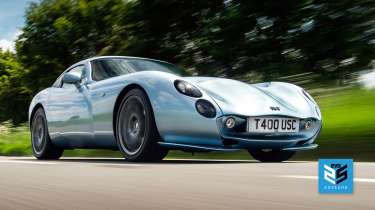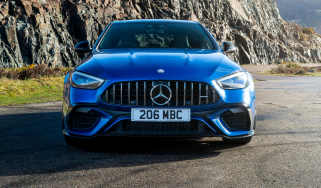TVR Tuscan (1999-2006): review, history, prices and specs
Fast and beautiful, the Tuscan remains one of TVR’s most appealing models over two decades on. Here's why it's one of our top 25 cars of the last 25 years
The 1990s and early 2000s will be looked back upon in the history books as TVR’s golden era. From the Griffith at the start of the decade until the Sagaris died out in 2006, TVR produced some of the most beautiful and exciting cars on the roads, and along with the Griffith and Cerbera, the 1999-2006 Tuscan will go down as one of the brand’s most iconic models.
TVR was already riding high when evo was launched. The glorious Griffith had won our hearts, the Chimaera was selling in its thousands and the wild Cerbera, complete with in-house ‘AJP8’ (later Speed Eight) engine, signified the company’s growing ambitions.
> Will the new TVR Griffith ever hit the road? New 'R&D centre' to open amid launch plan doubts
We’d enjoyed all of them during the latter years of Performance Car, so it was natural TVRs should feature regularly in the pages of our new baby. Peter Wheeler’s relationship with the motoring press was famously prickly, but thanks to the emollient efforts of TVR’s then PR man, Ben Samuelson, we managed to navigate our way through those turbulent waters sufficiently to find ourselves behind the wheel of pretty much every new car to emerge from Blackpool. They were special times.
More reviews
The Tuscan felt like a real watershed moment. It was significant. A statement car in looks and deeds. Wheeler never apologised for any of his cars, so it would be wrong to say this was the company’s first ‘no excuses’ effort, but everything about it was aimed at establishing TVR in a market dominated by AMG, BMW M and Porsche. Not to outsell them, but to outperform them and provide enthusiasts with a characterful and exciting alternative they could be proud to own.
Of course, TVR did things its own way. Being British and it being the early noughties, there was inevitably some (allegedly) tongue-in-cheek ‘fight them on the beaches’ jingoism. It suited the cars and the moment, but deep down it was Wheeler’s passion for engineering that drove product evolution and development.
The Tuscan was a thoughtfully conceived car. One that looked sensational and went like stink, but reflected Wheeler’s wish to tone things down a bit compared to the feral Cerbera. The l-o-n-g travel throttle served as a very effective traction control (no ABS or ESC, remember) and the softer suspension set-up was intended to further ensure the Tuscan didn’t bite its owners so readily. It was a fresh take on the classic Griff and Chimaera recipe and catnip for people like us.
Before writing this retrospective, I re-read my original Tuscan first drive from the June 2000 issue. Half expecting it to be light on criticism and generous with British bonhomie, I was pleasantly surprised to find I was very honest about its shortcomings. Most notably the strange lack of synchronisation between the firm front end and softer, traction-friendly rear. I also marked down power-assisted steering that was weighty but sharp and seemed to exacerbate the lack of unison between the responsive front end and roll-limited rear. It was a wonderful machine, but dynamically out of kilter.
That took some courage, because unlike the faceless bosses of huge multinational car companies, Wheeler was TVR. And because the cars – and particularly the Tuscan – were very much built to his taste, you knew that in criticising the car you were criticising him. Which was tough, because although a formidable character he was also a quietly spoken, disarmingly honest and thoroughly decent bloke.
Looking back, we were both right. The subsequent Red Rose upgrade really dialled in the way the Tuscan drove, but the fundamentals of the car that Wheeler laid down remain amongst the best modern interpretations of the classic front-engined rear-drive sports car. From the extraordinary styling and steampunk brass instrument binnacle (complete with in-house-made LCD display) to the snorting 4-litre Speed Six engine, the Tuscan was a car that seduced and adrenalised you in equal measure. It was the embodiment of evo’s ‘Thrill of Driving’ mantra.
If I close my eyes, I can still feel the control weights and rifle-bolt gearshift, not to mention the glorious, rorty, long-legged delivery of that stonking engine. With 360bhp and weighing just 1100kg it was a latter-day E‑type Jag or DB5 Aston, but a hundred times better to drive. And to think it cost £40k. For context, a 996 Carrera was £65k.
Today it seems inconceivable that a small, independent, free-spirited sports car maker could command such presence. It’s certainly ironic that the faster and more aloof today’s high-performance cars become, so we yearn for a car very much like the Tuscan: pure, light, potent and built upon the premise of prioritising on-road enjoyment. Peter, you were right…
For all these reasons and many more, the Tuscan ranks amongst the most enjoyable and fondly remembered cars I’ve ever driven. Flawed for sure and certainly not for everyone, it possessed an authenticity and, perhaps most crucially, attainability that was lost to all of us when TVR ceased trading. The last true sports car? I think it just might be.
TVR Tuscan in detail
The TVR Tuscan made its debut in 1999. But it was 2000 before the motoring press got its hands on the car, with TVR owner Peter Wheeler imposing a 12-month ban on media drives.
It was an agonising wait. If the car looks wild now, it’s hard to imagine its impact back then, with body lines broken only by circles for the headlights and tail lights, and a grille to give trypophobes nightmares. The car featured a removable targa-style roof panel for open-air motoring, and the details were glorious, from motorcycle-style exhaust cans to the wave-like double bonnet and frequent application of colour-shifting ‘reflex’ paintwork. The whole thing could have dropped in from another planet.
The interior was even more incredible, with organic curves that suggested the work of some sea creature and aluminium and brass details that, according to Richard Meaden driving the car in evo 020, were ‘something from the mind of Jules Verne’. Instruments were a mix of analogue and digital, the pedals floor-hinged, and ventilation through tiny eyeball vents that look more effective at cooling your crotch than anything else.
It was the powertrain that defined it as a true TVR though, with a four-litre in-line six of TVR’s own design. At launch the car already developed 360bhp at 7000rpm – but only if you pushed the long-travel throttle pedal down all the way – with 310lb ft of torque at 5250rpm. Your right foot provides both traction control and ABS, since the Tuscan had neither.
However, it wasn’t perfect, and on that first drive Meaden described it as a ‘dynamically disappointing sports car’, with mismatched responses between the front and rear axles. It took until the Tuscan 2 of 2005 for TVR to truly ‘fix’ the Tuscan’s handling, but in the meantime the car gained more power, first with the 380bhp Red Rose upgrade (which also brought track-biased chassis tweaks and AP Racing brakes), and later with the more finely honed Tuscan S, whose 390bhp power plant was backed up by aerodynamic improvements, most notably a small lip spoiler at the rear.
And that Tuscan 2 did bring about more serious improvements. Arguably not as pretty as the earlier cars – the odd front grille and more conventional rear light arrangement made the car less distinctive, certainly – basic versions made 350bhp, but were still lightweight (around 1100kg). Geometry changes, different spring rates, new bump stops and a slightly slower steering rack all made the car friendlier though, without taking away from the excitement factor.
The result was more progression, an improved ride quality on poor roads, but the retention of the Tuscan’s usual qualities such as excellent brake feel and incredible thrust. While the cabin design perhaps wasn’t as appealing as the original and the ergonomics as poor as ever, the Tuscan 2 was still the Tuscan at its very best – and by extension, one of the very best TVRs.
TVR Tuscan specs
|
Tuscan (1999) |
Tuscan S |
Tuscan 2 | |
|
Engine |
In-line six, 3996cc |
In-line six, 3997cc |
In-line six, 3994cc |
|
Max power (bhp @ rpm) |
360 @ 7000 |
400 @ 7000 |
350 @ 7200 |
|
Max torque (lb ft @ rpm) |
310 @ 5250 |
315 @ 5250 |
290 @ 5500 |
|
Weight |
1100kg |
1100kg |
c1100kg |
|
Power-to-weight |
333bhp/ton |
369bhp/ton |
c323bhp/ton |
|
0-60mph |
4.4sec (tested) |
4.0sec |
4.5sec |
|
Top speed |
180mph+ |
185mph |
165mph+ |
What we said
evo 020, ‘Tuscan Thriller’ (June 2000), Richard Meaden
‘Away from the test track it makes a devastating overtaking tool, snapping past slower traffic in clean, savage lunges of acceleration. The gearing is tall – third is good for 110mph – and the power delivery flexible, so you don’t need to work hard to make outrageous progress.
‘[But] the Tuscan has a few unwelcome discoveries in store. The steering is weighty, despite the help of power assistance… you have to practice restraint when applying lock, simply because the Tuscan turns in so sharply.. With such a pointy front end you expect the rest of the car to follow suit, with tight damping and a sharp all-of-a-piece feel. What you get is a deliberately soft set-up, with plenty of dive under braking and squat under hard acceleration.’
What to pay*
| Excellent | £40,000 |
| Good | £34,000 |
| Average | £27,000 |
| Project | £17,000 |
*Prices as of March 2024



